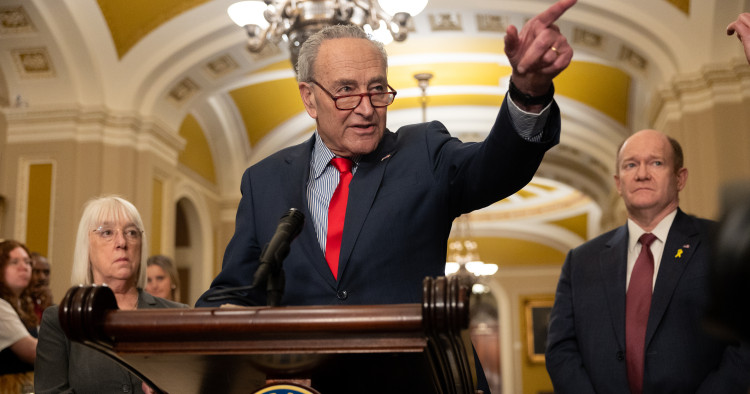Contents:
- How an emerging US-Israeli rift impacts Washington’s policy approach toward the war in Gaza
- Netanyahu’s war against the Biden administration
- Despite growing Iran-China-Russia military ties, Beijing still keeping Tehran at arm’s length
- Turkey and Iraq reach deal on jointly acting against PKK
- Syrian crisis nowhere near end, and set to worsen
How an emerging US-Israeli rift impacts Washington’s policy approach toward the war in Gaza
Brian Katulis
Senior Fellow for U.S. Foreign Policy and Senior Advisor to the President

-
A recent speech by Senate Majority Leader Chuck Schumer and some public statements and tactical policy shifts by the Biden administration have spotlighted the rifts between the United States and Israel on the Gaza war, with the greatest bilateral disagreements being over civilian protections for Palestinians, the humanitarian crisis in Gaza, and longer-term plans for what comes after hostilities end.
-
The Biden administration continues to seek a pathway toward a cease-fire and hostage release that could serve as an opening for wider diplomatic moves to end the conflict and stabilize the region.
Discussions and disagreements between the Biden administration and Israeli Prime Minister Benjamin Netanyahu, which had been rumbling behind closed doors for months, have increasingly begun to break out into the open. Senate Majority Leader Chuck Schumer’s speech last week pinpointing Netanyahu as an obstacle to peace and security for Israel generated significant controversy in both American and Israeli political circles. And President Joe Biden himself deepened this uproar by expressing support for Schumer’s words. In addition, the Biden administration imposed sanctions on two Israeli settlement outposts in the West Bank and three settlers it said were undermining security. Perhaps even more consequentially, the Biden administration issued a national security memorandum that seemed to hint it might seek to limit the arms it sends to Israel if the latter does not abide by certain conditions; though there are currently no clear signs of a fundamental shift in US-Israeli defense cooperation.
What impact might all of this recent turbulence have on the Biden administration’s policies aimed at advancing the five key goals it set for itself (supporting Israel and its war aims, securing the release of the hostages, preventing a wider regional war, protecting Gazan civilians and addressing the humanitarian situation, as well as maintaining a working relationship with other regional powers and stakeholders)? Not much, so far.
Whether these latest statements and moves represent a fundamental shift in the United States’ policy on Israel and Gaza remains to be seen because public statements not backed by broader policy shifts tend not to change the trajectory of conflicts driven by other actors — in this case, Hamas and Israel. In addition, public statements and tactical policy shifts, in the absence of a strategic review and shift in US policy, could end up producing unintended consequences and the opposite desired effects.
The Biden administration appears poised to continue to back Israel’s efforts to eliminate the security threat posed by Hamas, but the lack of clear metrics for defining success hampers the entire effort. A serious cause for concern among US officials is the perception they have about the lack of a clear plan for keeping civilians safe and addressing the humanitarian situation in the Gaza Strip, particularly as Israel considers a possible military operation in Rafah, the southern part of Gaza.
Some observers worry that a rift between the United States and Israel might raise the price Hamas seeks in the months-long negotiations over a temporary cease-fire and hostage release. Nevertheless, those negotiations are continuing, with an Israeli delegation heading to Qatar for another round of talks this week.
A public rift between Israel and the US offers a potential opportunity for regional adversaries such as Iran and its network of partners across the region. Yet on this front, the United States and Israel appear to remain fairly aligned strategically as both countries face threats from Iran and groups like the Houthis in Yemen, Hezbollah in Lebanon, and militias in Syria and Iraq. Some bigger strategic questions related to Iran loom, particularly its ongoing nuclear program. But the increasingly public debate between the US and Israel over the Gaza war has not yet affected Washington’s efforts to avert a wider regional war in a substantial way.
A key driver behind the recent policy moves and public statements by the Biden administration (and its political allies) is concern over signs of a growing famine in Gaza as well as the impact of war in Gaza and violence in the West Bank on the broader environment. The devolving humanitarian situation is why the US is leading an effort to create a temporary port in Gaza to deliver additional aid.
The public debate between Israel and the US on the conduct of the war in Gaza raises bigger questions about the gap between the United States, which has called for a two-state solution to the Israeli-Palestinian conflict, and Israel’s current government, which recently restated its opposition to the creation of a state of Palestine. Much of the rest of the region, except for Iran and its so-called Axis of Resistance, favors a two-state solution as well.
This past week’s turbulence in US-Israeli relations is the public surfacing of a dynamic that heretofore played out beneath the surface and mostly behind closed doors. This rift is not likely to go away, but it remains unclear how much the Biden administration is willing to undertake major shifts in its actual policy approach to the Israel-Hamas war.
Follow: @Katulis
Netanyahu’s war against the Biden administration
Eran Etzion
Non-Resident Scholar

-
If Israeli Prime Minister Benjamin Netanyahu were to agree to a cease-fire, change the composition of his cabinet, accept US principles for “the day after,” and cooperate on the humanitarian effort in Gaza, he might be able to partially salvage his government’s good relations with the White House; but most of these steps look highly unlikely because Netanyahu is seeking to preserve his power at all costs.
-
Netanyahu is waging war against the US administration by distorting reality about his own popular support as well the practicability of securing Israel’s stated war aims all while trying to equate himself with the Israeli state.
After 164 days of war, the longest in Israel’s history and with no end in sight, Prime Minister Benjamin Netanyahu is displaying signs of desperation. While not easily discernable to the average observer, the Israeli head of government is well aware of his rapidly deteriorating international image. United States Senator Chuck Schumer’s blunt assertions on the Senate floor, “Netanyahu has lost his way. Israel needs elections,” coupled with Vice President Kamala Harris’ sharp distinction between Netanyahu and the Israeli people, are leaving no room for error. The master politician — who built his career on importing American political campaigning methods to Israel, manipulating successive US presidents, and charming scores of hawkish members of Congress and Jewish mega-donors — is now being treated as persona non grata by Washington. It took President Joe Biden a long time to change his strategy, from “a bear hug” to something more akin to a “hornet swarm attack.” Nevertheless, the US seems to still be offering Netanyahu a way out. If he were to agree to a cease-fire, change the composition of his cabinet, accept Biden’s principles for “the day after,” and cooperate on the humanitarian effort in Gaza, he might still be “pardoned.” But most of these steps look highly unlikely. Netanyahu appears determined to hold on to power using any and all means — and if those include creating a rift with Israel’s most important strategic ally, so be it.
Netanyahu is waging war against the US administration using his all too familiar arsenal — distorting reality and trying to equate himself with the Israeli state. He is creating a false impression that the majority of Israelis stand with him, when in fact 80% want him out of office immediately, or once the war winds down (which is, arguably, the situation already). He has coined the phrase “total victory” as the alleged war goal, knowing full well that this will never be achieved. He blames the Americans and “the world” for not allowing Israel to “finish the job” vis-à-vis Hamas, when in fact his whole purpose is to never “finish the job” of being the prime minister. The stakes could not be higher for him, or for the White House. At play are Israel’s long-term national security on the one hand and Biden’s campaign and US regional standing on the other — a toxic mixture of strategic threats and political calculations. Meanwhile, Gaza has been turned into an unlivable enclave, Israel is more isolated than ever, and the US will need to lean in further and use more leverage if it is to create the necessary conditions for a prolonged cease-fire and a different Israeli partner.
Follow: @eranetzion
Despite growing Iran-China-Russia military ties, Beijing still keeping Tehran at arm’s length
Alex Vatanka
Director of Iran Program and Senior Fellow, Black Sea Program

-
Iran, China, and Russia recently completed Marine Security Belt 2024, their fifth trilateral military exercise since 2018, raising concerns over growing collaboration between the three countries at a time of rising tensions with the United States.
-
Despite closer military ties, Russia and China have done little to help Iran overcome US sanctions and aid its troubled economy; for now, Beijing is far more interested in cultivating economic ties with Washington’s Arab partners than it is in investing in Iran.
This past week, Iran, China, and Russia held another military drill in the Gulf of Oman. More than 20 ships, combat boats, support carriers, and navy helicopters participated in the exercise. Marine Security Belt 2024 is the fifth joint Iranian-Chinese-Russian military exercise since 2018, but some analysts view the drill in the context of rising tensions between the United States and Russia and China. The idea raised is that that Moscow and Beijing are meticulously working to equip Tehran, turning it into an even larger threat to Washington’s interests in the Middle East.
In this latest drill, for example, the presence of anti-ship missiles on participating ships signals a real challenge for the US Navy operating in the region’s waters, including in the semi-enclosed Persian Gulf. Still, if Russia and China really have such a plan for Iran — which is still a big if — then it is by no means a foolproof strategy. For one, it is disjointed. Above all, Iran is disappointed in how its two larger partners have failed to help it overcome American sanctions and aid its troubled economy.
Russia is even more sanctioned than Iran and cash-poor, but China’s reluctance to commit itself to strategic economic projects in Iran is the real alarm bell for many independent analysts in Tehran. Expectations were high after Iran and China signed a 25-year strategic agreement in 2021 designed to bring the two countries closer together. However, in the years since, China has invested far more in Iran’s Arab neighbors, such as Saudi Arabia, the United Arab Emirates, or even Iraq, and Tehran has been left hanging. Iranian officials keep reminding Beijing that their country is an ideal destination for Chinese investment — mostly due to lack of competition resulting from Iran’s ostracization from the West — but at best Tehran secures Beijing’s secondary economic projects.
The Chinese are signing long-term, multibillion-dollar deals with the likes of Qatar for energy but basically stay away from investing in Iran’s massive oil and gas reserves. Instead, the Chinese invest in lesser projects, like developing houses. China’s main interest in Iran is the purchase of crude oil — at a discounted rate — which is hardly a long-term commitment.
In recent years, Washington has fretted about Iran’s purported expanding ties with Beijing, worried that the Chinese — and the Russians — could manipulate Iran’s regional policies in a deliberate effort to undermine US interests. That might be a long-term aspiration; but for now, Beijing is far more interested in cultivating strategic economic ties with Washington’s Arab partners than it is in investing in the Iranian market. In that sense, the recent joint naval drill should not be the headline. The real headline is that China is still keeping Iran at arm’s length despite Tehran’s desperate overtures.
Follow: @AlexVatanka
Turkey and Iraq reach deal on jointly acting against PKK
Gönül Tol
Director of Turkey Program and Senior Fellow, Black Sea Program

-
In a landmark Turkish-Iraqi security deal, Baghdad officially labeled the Kurdistan Workers’ Party (PKK) a “banned organization” and the two countries promised to carry out a joint operation to uproot the group and establish a buffer zone inside Iraq.
-
The timing of last week’s accord points to larger, geopolitical dynamics at work: Ankara is making a play at becoming Baghdad’s security partner in a post-American Iraq, uprooting the PKK with the central government’s help, and pushing through the Iraq Development Road project, but Iraq’s security troubles stand in the way and may not be so easily resolved.
In what was dubbed a landmark security deal, Turkey and Iraq pledged, on March 14, to take joint action against the Kurdistan Workers’ Party (PKK), a group based in northern Iraq and labeled a “terrorist organization” by Ankara (as well as Washington). As part of the new agreement, Baghdad officially labeled the PKK a “banned organization” and the two countries promised to carry out a joint operation to uproot the group and establish a buffer zone inside Iraq. The move is indeed unprecedented. The PKK has been carrying out attacks against Turkey from Iraqi territory since the 1980s. In response, Turkey has conducted cross-border operations against PKK targets there but had heretofore failed to enlist Baghdad’s full commitment to take on the militant group. Why did the Iraqi side finally assent now?
The PKK certainly represents a security threat to both countries, but the timing of last week’s accord points to larger, geopolitical dynamics at play. Turkey has traditionally sought to exploit its strategic position along a major trade route for goods moving from Asia to Europe; thus, any shift to alternate transit corridors by international shippers would pose a significant challenge to Turkey’s economy. That is why President Recep Tayyip Erdoğan was furious when, on the sidelines of the G20 last year, US President Joe Biden and several partners announced plans to build a rail and shipping corridor linking India with the Middle East and Europe but bypassing Turkey. Erdoğan was quick to float an alternative route that would reinstate Turkey’s — and incidentally Iraq’s — geographic centrality: the Iraq Development Road. Erdoğan’s proposed corridor would cost $17 billion, include 1,200 kilometers of high-speed rail and roadway, and carry goods from southern Iraq via 10 Iraqi provinces into Turkey.
The plan is naturally appealing to both partners. From Baghdad’s point of view, such a corridor would generate badly needed transit revenues, thus helping Iraq diversify its economy away from oil dependency and boost its geopolitical stature. Ankara views the plan in a similar light, as well as a potentially lucrative opportunity for Erdoğan’s cronies in the construction sector. Yet the proposed route faces a number of substantial financial and security challenges. Turkey hopes to convince Gulf countries to finance the project, but the security situation needs to be addressed first. Hence, the announced “landmark security agreement” between Iraq and Turkey.
That is not all. The Turkish-Iraqi agreement materialized amidst a spike in fighting between Iranian-backed militias and US forces, which was inflamed by the Gaza war and has encouraged Iraqi calls for a full US withdrawal from their country. Bilateral negotiations on pulling out US troops have begun. And though American officials say a withdrawal might take up to five years, observers in Ankara believe it could happen much faster, especially if Donald Trump is re-elected to the White House. In that case, Turkey wants to fill the vacuum.
Ankara’s plan sounds perfect, on paper: Become Baghdad’s security partner in a post-American Iraq, uproot the PKK with the central government’s help, convince the Gulf countries to invest in the Iraq Development Road project, boost Turkey’s economy, enrich Erdoğan’s cronies, and enhance the country’s geopolitical clout. However, the feasibility of carrying out such an ambitious, multi-part strategy is in doubt. From widespread corruption to state dysfunction, Iraq has so many structural problems that it is very difficult to see Baghdad overcoming them in the near future. Then, there is the problem of Iran. Iraq occupies a much more critical place in Tehran’s regional calculations than it does for Ankara’s. For a sanctions-hit Iranian economy, Iraq is a critical market; and Iran plays an important political, economic, and security role in the Iraqi areas the proposed corridor would pass through. All these factors make Tehran a potential spoiler in any plan a competitor like Ankara envisions for Iraq. The planned US withdrawal, although potentially seen as an opportunity for Turkey, could further complicate things across the border, leaving neighboring Iraq unequipped to deal with its deep-rooted security problems.
In short, the agreement inked between Turkey and Iraq has generated much excitement. But the bigger plan Ankara nurtures behind the deal is unlikely to overcome the difficult Iraqi reality.
Follow: @gonultol
Syrian crisis nowhere near end, and set to worsen
Charles Lister
Senior Fellow, Director of Syria and Countering Terrorism & Extremism programs

-
Thirteen years since the start of the Syrian conflict, a vacuum of ideas, shared thinking, and multilateral action has now returned; and amid that impasse, the continuing crisis looks set to worsen.
-
The situation persists because every root cause and driver of the 2011 uprising remains, and almost all of them are worse today than they were then.
Syria’s crisis has now entered its 14th year and shows no sign of resolution anytime soon. While the lines of control may be largely frozen, the conflict itself is far from over, with active hostilities continuing in every corner of the country, involving a wide array of Syrian and foreign non-state and government actors. Meanwhile, the Syrian economy has never been weaker or more vulnerable and the humanitarian crisis is worse than ever before. Around 90% of Syrians are currently living under the poverty line, and 80% require daily humanitarian assistance; yet at the same time, the core foreign aid budgets for Syria are being cut by 20-40% in 2024, with wars in Ukraine, Gaza, Sudan, and elsewhere stretching funds to the breaking point.
With living conditions set to deteriorate dramatically in the coming months, instability is likely to rise still further. The war next-door in Gaza has triggered a significant intensification of geopolitical hostilities on Syrian soil, involving Hezbollah and other Iranian proxies, Israel, Jordan, and the United States. Meanwhile, regime attacks on northwestern Syria have increased markedly; signs of an ISIS recovery are increasingly clear in northeastern and central Syria; a tribal uprising in Deir ez-Zor has triggered months of attacks and clashes; Jordan has escalated ground and airborne military actions targeting regime-linked drug smugglers; Turkey’s drone campaign against the Kurdistan Workers’ Party (PKK) continues unabated; regime-associated inter-factional fighting has struck Hasakeh and Daraa; and an anti-regime protest movement in Suwayda persists.
Driven by a frustration at the long-standing diplomatic deadlock, regional states re-engaged President Bashar al-Assad’s regime in 2023. This “Arab Initiative” aimed to initiate a “step-for-step” process in which reciprocal concessions would build confidence for an eventual diplomatic resolution to Syria’s crisis. As it happened, Assad was granted his seat back in the Arab League and gratefully received a number of state visits and invitations abroad — but granted nothing in return. The Arab Initiative failed, spectacularly. Now deeply disenchanted with Assad’s obstinacy, regional states are continuing their periodic engagements, but any momentum that existed in mid-2023 is long gone. A vacuum of ideas, shared thinking, and multilateral action has now returned. And amid that impasse, Syria’s crisis continues and looks set to worsen.
At the end of the day, the crisis persists because every root cause and driver of the 2011 uprising remains. In fact, almost all of them are worse today than they were 13 years ago. Until the international community comes together and acknowledges that simple fact, Syria’s collapse into ever greater levels of chaos, instability, and human suffering will go on and on.
Follow: @Charles_Lister
Photo by Nathan Posner/Anadolu via Getty Images
The Middle East Institute (MEI) is an independent, non-partisan, non-for-profit, educational organization. It does not engage in advocacy and its scholars’ opinions are their own. MEI welcomes financial donations, but retains sole editorial control over its work and its publications reflect only the authors’ views. For a listing of MEI donors, please click here.













